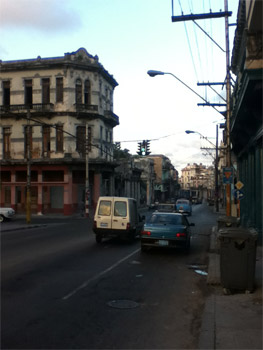Bicycling in Havana
Graham Sowa
 HAVANA TIMES — If a history of Cuba was examined from the perspective of petroleum one could call the time between the end of subsidized oil imports from the Soviet Union and the beginning of similar subsidization from the Bolivarian Republic of Venezuela the Period of the Bicycle.
HAVANA TIMES — If a history of Cuba was examined from the perspective of petroleum one could call the time between the end of subsidized oil imports from the Soviet Union and the beginning of similar subsidization from the Bolivarian Republic of Venezuela the Period of the Bicycle.
I arrived in Cuba well after the arrival of the first barrels of Venezuelan oil, but the effects of the Period of the Bicycle prevail. Bicycles are everywhere.
Unlike my home state of Texas the bicycle in Cuba is not just used as a weekend toy and yet another thing in our lives to buy accessories for. On the island it is an essential everyday form of transportation of people, goods, and services. As a random Cuban recently reminded me “Do doctors ride bicycles to work where you live? They do here.”
Of course some people get tired of peddling everywhere. So they started putting small two stroke engines on their bike frames to make homemade mo-peds; a portmanteau in name and function of ‘motor’ and ‘pedal’.
Some people tired of the pedaling part of the mo-ped, so they started being passengers on the ubiquitous bici-taxi. A misnomer to be sure, since every bici-taxi has three wheels, not two. But when someone else is doing the work I guess the passengers don’t really care what the contraption is called.
I decided I needed a bike just a few weeks after moving to Cuba. I took the first part of my search to the website www.revolico.com, a sort of Craigslist for Cuba. Or I tried to at least. The website was blocked when I attempted to open it.
So I decided to find a fellow student at the Latin American School of Medicine who was tired of having a bicycle and might be willing to part with it for a fair price. Within a few days I found a long neglected mountain bike, a bit too short for me, I admit, and its Colombian owner. At first my classmate balked at the prospect of a sale. But within a month or two he needed the money more than the bike he never used. So we did business, shook hands, and exchanged paper for metal.
Of course there are also those that bring their bikes from home. But with the ridiculous fees charged by the airlines for bicycle transport this did not make much sense to me. I was also much happier with my second hand purchase than my friends who bought new bikes here from stores that charge in convertible pesos. They paid more and their bikes break more often.
But even if you have a bike that breaks all the time, or maybe like many Cubans you just don’t have the money this year for a new set of tires, there seems to be at least one bicycle repair shop in every neighborhood.
Between the bici-taxis, that haul people as well as goods, the bike repair shops, and the bicycle market on places like revolico.com the bicycle has existed as a form of cuenta propia work long before such activity was officially legitimized about two years ago.
Once I started riding in Havana it was clear that the Period of the Bicycle had touched every respective mode of transportation that exists on the island. I feel that cars, buses and trucks give a much wider berth to cyclists here than at home. Even horses, a principal form of rural transport in Cuba, are unphased when passed by the relatively silent and sneaky bicycle.
Of course I think a big help in creating bike-friendly streets is the consistent presence of potholes and the worn out diesel engines powering around them. Both of these barriers to acceleration keep most vehicles from going too fast.
Right now my favorite cycling route is from the Calzada de Cerro, in south Havana, to Capitolio, then down Prado to the Malecon seawall. To avoid running into the Straits of Florida I hang a left and then pedal along the Malecon until I decide to head south again.
I ride around lower Vededo making the climb up Avenida de Los Presidents (Calle G). Then it is an easy ride from the Plaza de La Revolucion to the Estadio Latinoamericano and then back to the Covadonga (Hospital Salvador Allende).
Spanish colonial city planning has made the city very navigable. Almost every neighborhood is laid out in a grid. That means riding east to west in Playa or Vedado is easy, with few hills and elevation change. If you want to get winded go to south Havana and ride the street aptly called La Vibora. Of course any time you just want to let gravity take over just aim for the sea. It is all downhill from there.

hey thanks for the info on bikes for cuba. i’ll definitely be checking that out!
Saw your blog , now on my fave list . I had a fabulous time on a bike in Cuba . The respect for bikes is evident ,I went out for a few rides with a High school bike club in Jaguey Grande, the coachs teaching the young riders pelleton riding . The drivers were more than respectful ‘ it was a refreshing experience. Bicycles ae traffic in Cuba , and as a old cyclist a bici – taxi tour of Jaguey , with a cold Bucanero was a experience. Bad with links but Jeff reid at “Bikes for Cuba ” introduced me to the club Cheers